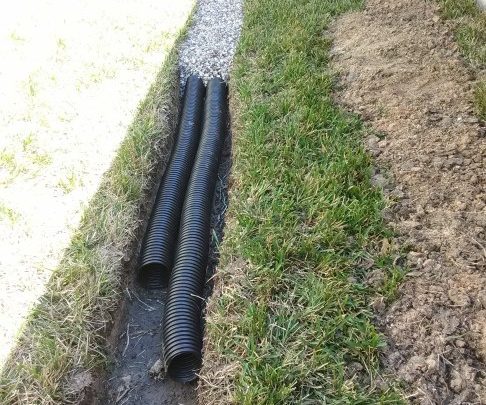Water pooling in your yard after every rainstorm isn’t just an eyesore. It’s a warning sign that your property needs better drainage, and ignoring it can lead to foundation cracks, landscape erosion, and basement flooding that costs thousands to repair. According to recent studies, poor drainage contributes to nearly 60% of foundation problems in residential properties, making it one of the most common yet preventable issues homeowners face. At Accurate Lawn Leveling, we’ve helped countless property owners transform soggy, problematic yards into well-drained outdoor spaces that stand up to heavy rainfall with our French drain installation service.
Our team understands that effective water management starts below the surface, which is why French drains remain one of the most reliable solutions we recommend for long-term drainage problems. If you’re dealing with standing water, musty basement odors, or soil that stays saturated long after the rain stops, a French drain system might be exactly what your property needs.

What Makes French Drains So Effective
A French drain works through elegantly simple engineering. The system consists of a sloped trench filled with gravel and a perforated pipe that redirects water away from problem areas. Water naturally flows downhill through the gravel, enters the perforated pipe, and gets channeled to a safe discharge point away from your home’s foundation or landscaping.
The beauty of this design lies in its passive operation. Unlike sump pumps that require electricity and regular maintenance, French drains rely entirely on gravity. Once properly installed, they work continuously without any power source, making them both cost-effective and environmentally friendly.
Understanding the Installation Process
Installing a French drain requires careful planning and precise execution. The trench must be dug at the correct depth, typically 18 to 24 inches, with a consistent slope of at least one inch per eight feet of length. This gradient ensures water flows freely without pooling or backing up inside the system.
Professional installation involves lining the trench with landscape fabric to prevent soil from clogging the gravel and pipe. The perforated pipe gets positioned with holes facing downward, contrary to what many people assume. This placement allows water to enter from the bottom of the trench where it naturally collects, improving the system’s efficiency.
The surrounding gravel acts as a filtration layer while creating space for water to move freely toward the pipe. Coarse gravel works best because it resists compaction and provides maximum drainage capacity. Finally, the trench gets covered with soil or decorative stone, depending on your aesthetic preferences and landscape design.
Maintaining Your Drainage System
French drains require minimal maintenance when installed correctly, but they’re not entirely maintenance-free. The most important task involves keeping the discharge point clear of debris, leaves, and sediment that could block water flow. A quick inspection after major storms helps ensure everything continues working properly.
Over time, fine soil particles can gradually work through the landscape fabric and settle in the gravel layer. This process happens slowly over many years, but it can eventually reduce drainage efficiency. Professional cleaning every five to seven years removes accumulated sediment and restores optimal performance.
Tree roots pose another potential concern, particularly if your French drain runs near mature trees. Roots naturally grow toward moisture, and they can penetrate perforated pipes if given enough time. Choosing the installation route carefully and using root barriers when necessary helps prevent this problem before it starts.
The Benefits Extend Beyond Drainage
Property owners who install French drains often notice improvements they didn’t anticipate. Healthier lawns develop because grass roots no longer sit in saturated soil that promotes disease and inhibits growth. Garden beds become more productive as plants receive adequate moisture without drowning. Mosquito populations decrease significantly when standing water disappears from the property.
Foundation protection represents the most valuable benefit. Water that accumulates against basement walls creates hydrostatic pressure that can crack even well-constructed foundations. By intercepting water before it reaches your home’s perimeter, French drains eliminate this pressure and prevent costly structural damage that only worsens with time.
The investment in a French drain system pays dividends through increased property value and reduced maintenance costs. Potential buyers appreciate homes with proper drainage, and you’ll spend less money repairing water damage or fighting persistent moisture problems.
Moving Forward With Confidence
Understanding how French drains work helps you make informed decisions about protecting your property from water damage. These systems offer proven, reliable performance that stands the test of time when installed with quality materials and proper technique. Contact Accurate Lawn Leveling today for a professional assessment of your property’s drainage needs. We’ll evaluate your specific situation and recommend the most effective solution to keep your yard dry and your foundation protected.
